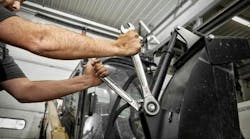One of the best attended educational sessions during the Automotive Aftermarket Products Expo at the Sands Expo Center was the update on telematics, a standing-room-only meeting. The high level of interest in this session reflected the concern in the aftermarket that telematics, which allows transferring car-generated information via telecommunications to a remote device, presents a big challenge to the aftermarket.
The session was arranged to give aftermarket members a better idea of how telematics is evolving and what it means to the aftermarket. The Automotive Aftermarket Industry Association (AAIA) has joined with other industry groups to assess the competitive threat the aftermarket faces from carmakers who are introducing telematics as a way to steer aftermarket services to their dealers.
Attendees learned that telematics solutions are growing, but that automakers are experiencing some issues trying to develop it as a viable customer offering. This has given the aftermarket time respond to automakers’ efforts to use telematics to their competitive advantage.
Attendees heard from Roger Lanctot, associate director of automotive for Strategy Analytics, a research firm, and Eric Berkobin, vice president of engineering at Verizon Telematics, the winner of the 2013 Aftermarket Telematics Challenge. The session was moderated by Scott Luckett, AAIA chief information officer.
Luckett began the session by playing a Chevrolet commercial about OnStar telematics. The commercial noted that drivers can check emails while driving and get maintenance notifications. “The monetization from telematics from the car companies is in the VRM (vehicle relationship management),” Luckett said.
All major carmakers are developing a telematics solution, he said. He noted that BMW will be introducing telematics to all new cars in 2014. The system will provide remote diagnostics and automatic crash notification to owners at no extra charge for 10 years, he said.
“The aftermarket is thus far ‘offline’ with the vehicles and hoping to react,” Luckett noted. “Our interest is in the consumer’s right to choose where to have their vehicle serviced.”
He said telematics can be added to all vehicles built since 1996.
Luckett said AAIA wants to work with automakers in establishing technical standards for telematics products. To this end, AAIA has partnered with the Automotive Aftermarket Suppliers Association, AIA Canada, the Equipment Technology Institute and other groups in forming an aftermarket telematics task force.
“We’ll be on Capitol Hill talking about telematics,” he said.
Luckett said European countries have mandated telematics in cars beginning in 2015 in the interest of improved safety. “Telematics has basically been mandated in Europe,” he said.
Roger Lanctot, the researcher, then expanded on the various forms that telematics solutions have taken so far.
Insurance companies are supporting the development of automotive telematics, he noted, for both new cars and the aftermarket. “Aftermarket telematics is getting a big push from the insurance companies,” he said, noting that insurance companies are able to customize insurance policies to individual policyholders based on data generated by the consumers’ vehicles.
Lanctot showed slides of the numerous telematics products that have been introduced. He said there are some solutions that are smartphone-based and some that are used in conjunction with customer relations management software. He said the solutions use a variety of data gathering hardware and software.
Progressive Insurance promotes a telematics solution that has been installed in 1.5 million vehicles, he said.
CarMD, a Website that provides consumers information to lower the cost of vehicle ownership, has also promoted telematics, as has the American Automobile Association.
Despite all the telematics products that have been introduced, Lanctot said telematics has not yet become a mass-produced product and that most consumers are not aware of it. “We’re not there yet,” he said. “We (the automotive industry) have to figure out the message. The power of this is what it could become, not what it is.”
Automakers have introduced maintenance notification in some of their telematics solutions, he said. But they are struggling in coming up with a solution that will provide value at a cost consumers are willing to pay. Automakers have learned that customers don’t want to pay for the information these systems have been able to provide thus far.
“You (the carmaker) don’t want to make the customer pay for the embedded unit in the car,” Lanctot said.
He said it will take the automakers three to five years to figure out how to develop a marketable telematics solution, which gives the aftermarket time to react.
In addressing the aftermarket’s options with telematics, Lanctot noted that independent aftermarket shops may be able to come up with solutions similar to RepairPal, a provider of auto repair and maintenance information that directs consumers to independent shops.
He noted there is an aftermarket telematics solution called CarShield. CarShield, which Lanctot characterized as a small player, uses a digital transceiver to provide remote monitoring, email alerts, diagnostic reports and notification of unauthorized movement, according to its Website.
Summarizing the future of automotive telematics, Lanctot said: “This is a business model that hasn’t been taken on yet.”
Eric Berkobin of Verizon Telematics then described his company’s telematics solution. Verizon’s “InDrive” device is a plug-in solution that can connect to most vehicles built in 1996 and after. Its features include safety and security, convenience, diagnostics, emissions notifications and data analysis, Berkobin said.
As far as the competitive threat from automakers is concerned, Berkobin said he is not sure if automakers will ever provide telematics on a large scale. He said they have yet to prove they can give consumers something they want.
Berkobin said insurance companies have been great supporters of his product. They are not competitors. “Insurance companies don’t like being in the hardware business,” he said.
.


